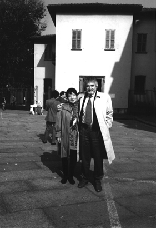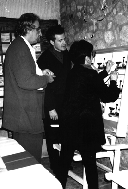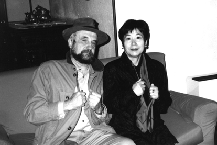
| There was actually another reason I went to Europe. In a town that lies near the railway connecting Milan and Venice, live three of the biggest Italian Fluxus collectors. In the past, they had told me that if I ever had a chance, they would very much like me to visit them. It was a good time because one of them, Luigi BONOTTO of Molvena, had recently produced a peculiar edition of bottles called "Grappa Fluxus" that were designed by about ten Fluxus members. Since my glass was finished, I was going there to sign it. After we had arrived in Verona the next morning, Mr. Bonotto, bringing a young interpreter with him, lost no time in coming to our hotel and picking us up. It was the first time I had met this large-framed, warm-hearted gentleman. On the way to his house, we stopped at the ruins of an old castle where a human chess tournament takes place once every four years. The center of the square had indeed been covered with two colors of stone to form a chessboard. Long ago when a number of young men were fighting over the beautiful daughter of a noble family, these chess games were used to decide the winner. Incidentally, Tendo City, in Yamagata Prefecture, similarly known for its human shogi (a Japanese game resembling chess) matches, happens to be Molvena's sister city. |  |

|
At the edge of some gently rolling hills covered in green was Mr. Bonotto's house. Once inside, I was astounded. In not only the guest room and along the staircase, but in the kitchen and in the bathroom, there were a tremendous number of new Fluxus works lining the crowded house. It was truly a living museum. All of them were in frames or cases that he had designed and ordered for himself, and in a single glance, it was clear how well he cared for them. For a series of large cloth works, he had attached a rail to the ceiling to suspend the exact number of objects and had designed a mechanism to allow them to be shown one at a time to a visitor seated on the sofa. Among these were works in process that were being completed little-by-little each time the artist visited. "Whenever you come here, something has changed. And this house has become a kind of meeting place for the Fluxus artists," said the interpreter, Mauro, a company worker. Mr. Bonotto himself started out as an artist, but is now running his own textile company and designing cloth for fashionable clothes for young people. He showed us part of the factory, adjacent to his house, and it was quite magnificent; he said he exports a lot to foreign countries, especially Japan. |
| That afternoon we visited Massimo, a glass craftsman, at his workshop. And all at once, right before our eyes, he made a new version of the work I had designed. It was a terrific display of skill. Next, he asked me to sign the twelve blue, clear bottles, similar in appearance to wind instruments, that he had already finished, and brought me a heavy, metal pen that was electric and oscillated minutely. I practiced a number of times on another cup, but because blue glass is especially hard, it was like trying to stand on ice for the first time with skates on--the tip of the pen was beyond my control. In this extremely nervous state, with his help, I was somehow able to sign all of them. By the time I had finished, my hand was exhausted and quivering. If nothing else, it was an appropriately shocked signature for someone who had come from so far away. Just then, as the sun was setting over the hills of Molvena, the sound of bells from churches all around began to ring through the air. |

|

|
According to one view, he is the biggest collector in Europe. The works he owns are stored in two warehouses located just thirty minutes by car from Verona. About ten years ago, he published various editions of two-dimensional works by Fluxus artists by printing them on flags or large pieces of cloth, and it is through the sale of these that he presently earns a living. He has been involved with the planning of a countless number of exhibitions, and just finished with a big Fluxus show in Bassano with Mr. Bonotto and others last summer. The number of photographs of Fluxus artists he has taken approaches 150,000. Throughout the three hours I was with him, since this was such a rare opportunity, he was continuously taking my picture and had to change film three times. Then, saying, "This book is my life, I want you to write something in it and sign it," he brought over a huge sketch book. As he turned the pages, he joyously explained in great detail who had written what. This man, who became so completely absorbed that he exchanged his family for Fluxus, is now sixty-years-old. "When I die," he worries, "What's going to become of my enormous collection?" In the way he drifted between solitude and sorrow, I was suddenly reminded of MACIUNAS. What should he do to ensure that his mission in life has been accomplished and that the dream he has been trying to grasp isn't an illusion? The next morning on the cliffs near Castel San Pietro, I shot one of Robert WATTS's arrows to satisfy Mr. Conz's mania for documentation. |
| GREETINGS | SUZUKI Akio part three |
FUJISHIMA Yutaka essay |
SHIOMI Mieko Fluxus in Italy |
Joe JONES Interview |
Christopher Stephens drawings |
CREDITS |
| Back to Carl Stone Home | Back to Xebec Home | |||||